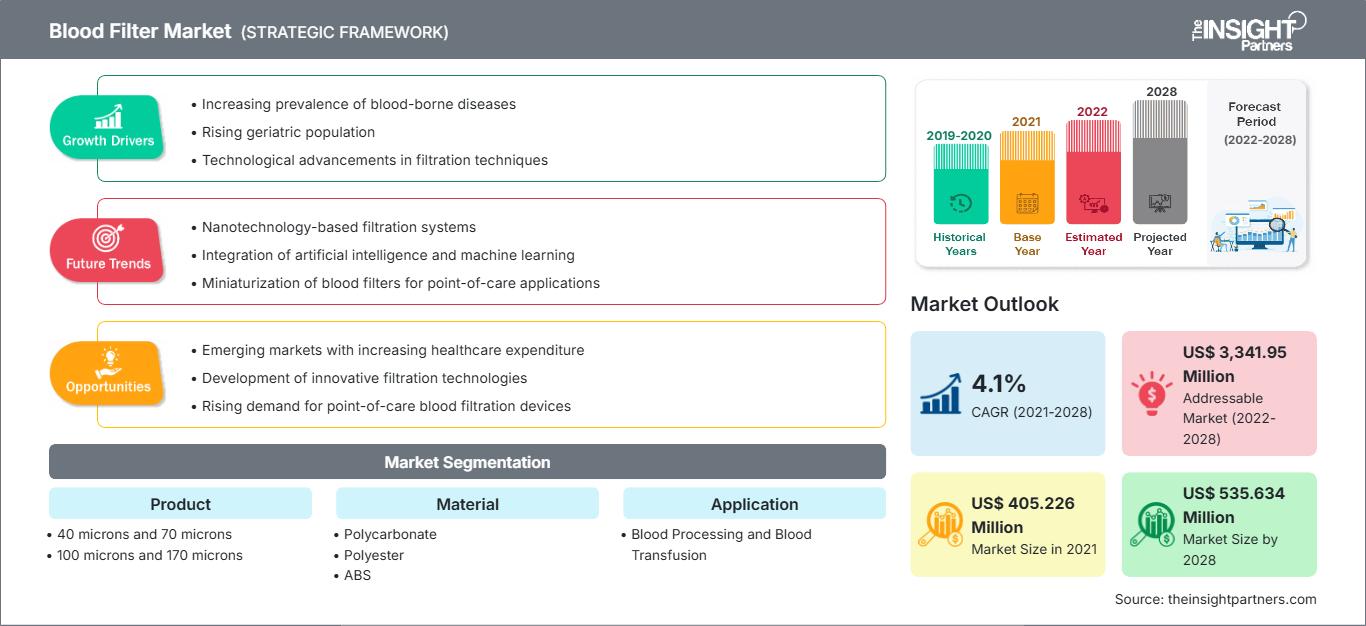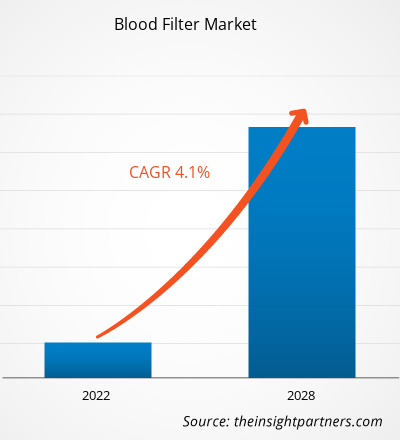Le marché des filtres sanguins devrait atteindre 535,634 millions de dollars américains d'ici 2028, contre 405,226 millions de dollars américains en 2021 ; sa croissance devrait atteindre un TCAC de 4,1 % entre 2021 et 2028.
Un filtre sanguin est un filtre de type tamis composé d'une maille tissée en polyester ou en nylon, placé entre la poche de produit et le patient pour effectuer la filtration. Ces filtres sont destinés à protéger les patients des macro-agrégats et des particules non sanguines qui pourraient être dangereuses en cas de pénétration dans la circulation sanguine. Ils éliminent les macro-agrégats tels que les sites de micro-agrégats et les agrégats de fibrine lors d'une transfusion sanguine. La filtration consiste à capturer les particules et les macro-agrégats fabriqués à partir de leucocytes, de fibrine et de plaquettes, formés pendant le stockage du sang. Des facteurs tels que l'augmentation du fardeau des maladies chroniques, la hausse des traumatismes et des accidents, et l'augmentation du nombre de transfusions sanguines stimulent la croissance du marché des filtres sanguins. Cependant, les rappels de produits freinent cette croissance.
Vous bénéficierez d’une personnalisation sur n’importe quel rapport - gratuitement - y compris des parties de ce rapport, ou une analyse au niveau du pays, un pack de données Excel, ainsi que de profiter d’offres exceptionnelles et de réductions pour les start-ups et les universités
Marché des filtres à sang: Perspectives stratégiques

-
Obtenez les principales tendances clés du marché de ce rapport.Cet échantillon GRATUIT comprendra une analyse de données, allant des tendances du marché aux estimations et prévisions.
Aperçu du marché
L'augmentation du nombre de transfusions sanguines stimule la croissance du marché des filtres sanguins
L'amélioration de la disponibilité de sang sûr et adéquat pour les transfusions devrait faire partie intégrante de la politique et des infrastructures de santé nationales de chaque pays. Le besoin de transfusion sanguine peut survenir à tout moment, en zone urbaine comme rurale. Par le passé, l'indisponibilité de sang a entraîné le décès de nombreux patients souffrant de problèmes de santé. Un approvisionnement suffisant et fiable en sang sûr peut être assuré en disposant d'installations stables pour les donneurs de sang réguliers, volontaires et non rémunérés. Ils constituent également le groupe de donneurs le plus sûr, car la prévalence des infections transmissibles par le sang est la plus faible parmi ces donneurs.
Les interventions chirurgicales les plus courantes nécessitant une transfusion sanguine comprennent les interventions cardiovasculaires, les césariennes et les blessures. Selon les estimations du National Heart, Lung, and Blood Institute et des National Institutes of Health (NIH), aux États-Unis, plus de 5 millions de personnes ont besoin de transfusions sanguines chaque année. De plus, en raison de catastrophes naturelles et de décès à grande échelle, la demande de transfusions sanguines augmente partout dans le monde. L'augmentation de l'incidence de maladies sanguines telles que l'anémie, l'érythrocytose, la leucocytose, la leucopénie et la thrombocytose stimule également la croissance du marché des filtres sanguins. Selon l'OMS, la plupart des enfants atteints de thalassémie naissent dans des pays à faible revenu, où l'accès à la transfusion sanguine est difficile ou réservé à un faible pourcentage de la population. Les filtres sanguins utilisés lors des transfusions sont des mailles tissées en polyester ou en nylon ; ce sont des filtres de type écran placés entre la poche de produit et le patient. Ces filtres sont conçus pour protéger les patients des macroagrégats potentiellement nocifs tels que les plaquettes, les leucocytes, les protéines de fibrine et les particules non sanguines. Dans la majorité des pays développés, les filtres de transfusion sanguine sont fournis par les gouvernements ou des programmes communautaires. Ainsi, la disponibilité d'installations adaptées au don de sang et aux donneurs volontaires stimule le nombre de transfusions sanguines, ce qui stimule la croissance du marché des produits de comblement sanguin.
Informations sur les produits
En fonction du produit, le marché des filtres sanguins est segmenté en 40 et 70 microns, 100 et 170 microns, entre autres. Le segment des 100 et 170 microns devrait détenir la plus grande part de marché en 2021 et devrait enregistrer un TCAC plus élevé au cours de la période de prévision.
Informations sur les matériaux
En fonction du matériau, le marché des filtres sanguins est segmenté en polycarbonate, polyester, ABS, entre autres. Français Le segment du polyester détiendra la plus grande part de marché, soit 35,47 % en 2021, et devrait conserver sa position dominante pendant la période de prévision.
Informations basées sur les applications
En fonction des applications, le marché des filtres sanguins est segmenté en traitement du sang et transfusion sanguine. Le segment de la transfusion sanguine détiendra la plus grande part de marché, soit 73,83 %, en 2021, et devrait conserver sa position dominante pendant la période de prévision.
Informations basées sur l'utilisateur final
En fonction de l'utilisateur final, le marché des filtres sanguins est segmenté en banques de sang, hôpitaux et autres. Le segment des banques de sang détiendrait la plus grande part de marché de 47,38 % en 2021 et devrait conserver sa domination au cours de la période de prévision.
Diverses entreprises opérant sur le marché des filtres sanguins adoptent des stratégies telles que des lancements de produits, des fusions et acquisitions, des collaborations, des innovations de produits et des extensions de portefeuille de produits pour étendre leur empreinte mondiale, maintenir la marque et répondre à la demande croissante des utilisateurs finaux.
Marché des filtres à sang
Les tendances régionales et les facteurs influençant le marché des filtres sanguins tout au long de la période de prévision ont été analysés en détail par les analystes de The Insight Partners. Cette section aborde également les segments et la géographie du marché des filtres sanguins en Amérique du Nord, en Europe, en Asie-Pacifique, au Moyen-Orient et en Afrique, ainsi qu'en Amérique du Sud et en Amérique centrale.
Portée du rapport sur le marché des filtres à sang| Attribut de rapport | Détails |
|---|---|
| Taille du marché en 2021 | US$ 405.226 Million |
| Taille du marché par 2028 | US$ 535.634 Million |
| TCAC mondial (2021 - 2028) | 4.1% |
| Données historiques | 2019-2020 |
| Période de prévision | 2022-2028 |
| Segments couverts |
By Produit
|
| Régions et pays couverts |
Amérique du Nord
|
| Leaders du marché et profils d'entreprises clés |
|
Densité des acteurs du marché des filtres sanguins : comprendre son impact sur la dynamique commerciale
Le marché des filtres sanguins connaît une croissance rapide, portée par une demande croissante des utilisateurs finaux, due à des facteurs tels que l'évolution des préférences des consommateurs, les avancées technologiques et une meilleure connaissance des avantages du produit. Face à cette demande croissante, les entreprises élargissent leur offre, innovent pour répondre aux besoins des consommateurs et capitalisent sur les nouvelles tendances, ce qui alimente la croissance du marché.
- Obtenez le Marché des filtres à sang Aperçu des principaux acteurs clés
Marché des filtres sanguins - par produit
- 40 microns et 70 microns
- 100 microns et 170 microns
- Autres
Marché des filtres sanguins - par matériau
- Polycarbonate
- Polyester
- ABS
- Autres
Marché des filtres sanguins - par application
- Traitement du sang
- Transfusion sanguine
Marché des filtres sanguins - par par utilisateur final
- Banques de sang
- Hôpitaux
- Autres
Marché des filtres sanguins - par géographie
- Amérique du Nord
- États-Unis
- Canada
- Mexique
- Europe
- France
- Allemagne
- Italie
- Royaume-Uni
- Espagne
- Reste de l'Europe
- Asie-Pacifique (APAC)
- Chine
- Inde
- Corée du Sud
- Japon
- Australie
- Reste de l'Asie-Pacifique
- Moyen-Orient et pays d'Asie-Pacifique Afrique (MEA)
- Afrique du Sud
- Arabie saoudite
- EAU
- Reste du Moyen-Orient et de l'Afrique
- Amérique du Sud et centrale (SCAM)
- Brésil
- Argentine
- Reste de l'Amérique du Sud et centrale
Profils d'entreprise
- Asahi Kasei Corporation
- Fresenius Kabi AG
- Macopharma
- Haemonetics Corporation
- Infomed SA
- KANEKA CORPORATION
- Laboratoires Kawasaki. Inc.
- Sefar AG
- Shandong Zhongbaokang Medical Implements Co., Ltd.
- Nanjing Shuangwei Biotechnology Co., Ltd.
- Analyse historique (2 ans), année de base, prévision (7 ans) avec TCAC
- Analyse PEST et SWOT
- Taille du marché Valeur / Volume - Mondial, Régional, Pays
- Industrie et paysage concurrentiel
- Ensemble de données Excel
Rapports récents
Rapports connexes
Témoignages
Raison d'acheter
- Prise de décision éclairée
- Compréhension de la dynamique du marché
- Analyse concurrentielle
- Connaissances clients
- Prévisions de marché
- Atténuation des risques
- Planification stratégique
- Justification des investissements
- Identification des marchés émergents
- Amélioration des stratégies marketing
- Amélioration de l'efficacité opérationnelle
- Alignement sur les tendances réglementaires






















 Obtenez un échantillon gratuit pour - Marché des filtres à sang
Obtenez un échantillon gratuit pour - Marché des filtres à sang